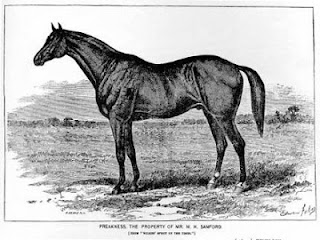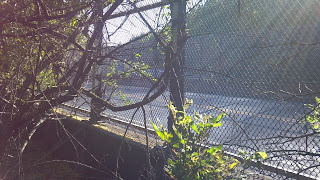It seems a little weird to compare the reopening of Sandy Hook to Christmas, but in my case, it works. It's long been the place where I can go to get some peace, and it's one of the spots on Earth that just make me feel good without even trying. Even in the dead of winter, I can usually find a good adventure or, with Ivan, an interesting feathered visitor.
Anyway, May 1 has been on my calendar as the official reopening date for the Hook post-Hurricane Sandy, and I couldn't wait. I woke up sometime around 4:30 a.m. and couldn't get back to sleep, so I opted to make an early start. Sunrise was at 5:55, giving me plenty of time do all my morning stuff and hit the highway by daybreak.
The Park Service has done a great job of setting expectations on restoration through their Facebook page, but I didn't know what to expect in terms of visitation. Weather already looked wonderful, making it as good a day as any to play hooky from work, at least for the morning. Would there be a crowd?
When it came to birds, it was anyone's guess. Since nobody's been birding there all spring (or just hasn't reported, if some lucky duck got access), it's hard to know whether the storm's impact has changed the place enough to make it unattractive to some species and more attractive to others.
Whatever the case, I was eager to get there and find out for myself. As I took the Route 36 bridge over the Navesink River, I couldn't help but let out a whoop of happiness. I can recall having that kind of happiness entering the park on a beautiful summer morning, or at any other time of the year when I needed to recharge my batteries with a day on the Hook. I didn't realize how much I missed it, though, until I drove through the entrance plaza and my eyes teared up. Roads are still rough in places (they've been milled and some are yet to be repaved), but knowing they'd been covered with sand, I was happy they were entirely passable. And it seemed that I'd gotten there before just about everyone but the fishermen.
 |
The landscapers have come!
Battery Peck hasn't looked this good in a long time. |
My plan was to make my way to the warbler trail next to Battery Peck and Nine Gun near the tip of the Hook, and then check out some other birding spots along with Fort Hancock. Given the time of year, it seemed like the best approach.
Except that it wasn't. I neither saw nor heard a single warbler in the tight foliage along the path, though plenty of red-winged blackbirds and robins were around. Perhaps, I thought, the warblers were waiting for their breakfast bugs to warm up in the early morning sun. Either that, or they'd already come and gone.
 |
| The worst of the damaged porches on Officers Row. |
On the way to my next stop, the scout camping grounds, I wound my way around Fort Hancock. I happily found a pair of osprey making a cozy home atop the Officers' Club chimney, and several others on the wing. The park's closure meant I couldn't make my usual mid-March visit to check on their annual return, and I was glad to see so many nesting around the Hook. Maybe they weren't as plentiful as blackbirds, but for a few minutes they certainly seemed to be.
Overall, as I drove around, I saw that many of the buildings had taken at least a small hit from the storm, from busted windows to missing roof shingles. Probably the worst I saw was the old mule barns near the Coast Guard base, which were accessible only by boat for a few weeks after the storm. Most of the Officers' Row houses now suffer the indignity of propped-up porch roofs and missing front and/or back steps, though it also appears that the stabilization boarding over the windows is new. The brick work all seems to have held up: those structures were built to last.
 |
| There's nothing like new barbecue equipment! |
The scout camp, when I got there, was a tiny bit more productive from a birding perspective. In fact, it was tea time according to the most prevalent song birds there. The call of the normally delightful Eastern towhee has been described as "drink your teaaaaaa," but most of these guys simply sang the last two notes. They had me hunting for a bit, until one handsome fella perched atop a shrub, singing for all to see in the bright morning light. He was just the first of many who made themselves visible on my rounds. Perhaps a flight had come in overnight, or maybe procurement sent the Park Service towhees instead of warblers, but I hadn't seen so many in one place ever.
 |
The boardwalk and deck
on Spermaceti Cove
were removed by the hurricane. |
Still, though, I was a bit frustrated by the seeming lack of avian diversity, and as I ran into other birders, they admitted being just as disappointed. Walking the multi-use path will often reveal a wide range of birds, but the only ones who'd show themselves were annoyed house wrens and a pair of house finches. The lighting, however, was fantastic, illuminating the iridescence of a grackle as I'd never seen before. Absolutely gorgeous!
I also walked the maintenance road and bayside beach near Batteries Kingman and Mills, finding more towhees in the brush and a gathering of late-staying brant and a merganser in the water. Without realizing it, I antagonized a pair of osprey nesting on the land side of Kingman, an area I hadn't known was equipped with a platform for them. They seemed to be doing much better than the less-than-wise pair who were building a nest on a utility pole next to the road.
It'll probably take some time to determine the impact the hurricane has had on the flora and, by extension, the birds' feeding opportunities on the Hook. As I was reminded by one of the friendly NPS maintenance people I ran into, the peninsula had been hit with 13 foot storm surges, and the resulting flooding had to have made its mark.
For the time being, there are still repairs to be made. Superficially, there's road repaving and reconstruction of wooden walkways, most remarkably the boardwalk and observation deck at Spermaceti Cove, now totally gone. Long term, the park still needs major infrastructure improvements, including the sanitary sewer system. If you're planning a trip there, consider stopping by the Wawa or Quick Chek on 36 as you approach the park. The porta-johns were very clean when I checked, but, well, why go rustic if you don't have to? In any case, it's a small inconvenience when compared to the joy of being back on the Hook.

 Binoculars always in hand, Ivan wanted to explore the stand of trees near the parking area, so in we went. We quickly felt enveloped by pitch pines, reminding us that we were, after all, in the outer reaches of the Pinelands. While blotches of sunlight shone down through hurricane-created holes in the canopy, the gnarled trees made the place feel unnatural and weird. I couldn't wait to get out.
Binoculars always in hand, Ivan wanted to explore the stand of trees near the parking area, so in we went. We quickly felt enveloped by pitch pines, reminding us that we were, after all, in the outer reaches of the Pinelands. While blotches of sunlight shone down through hurricane-created holes in the canopy, the gnarled trees made the place feel unnatural and weird. I couldn't wait to get out.











